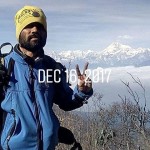RISING GIANTS
The dense moist forest of bamboo, a stretch of four to six hour’s gruelling hike, is left behind and our team trudged up the patch of meadows which had started to appear by now. As we climbed high ,mount Kanchenjonga (8595 m.) and the mountain chain of greater Himalaya appeared to rise higher, behind our back. The panoramic view was unearthly, afternoon sun gleaming off the high and white mountain ranges too brightly for the naked eye to fully appreciate. Each turn , every pause for breath seemed like an excuse to look back and admire at the marvellous view. Our route touched a yak stable at the head of the first substantially large meadow, then continued for the next meadows up the mountain slope.

Kanchenzonga zonga South, Central and Main (L-R) standing head high over a sea of cloud, as we hike up
It was 2 pm, by now the sea of clouds from the bottom of Teesta valley has risen high, riding the sun baked air. As a fine, discontinued veil of cloud gathered among the scrubby meadows, we managed to reach the intended stable for night stay, which was a worn out hut near a tiny trickling stream, at the foot of a steep bugiyal (meadow).
THE MOUNTAINS AT DAWN
The cold windy December night was long and sleep was hard to come by, I checked my watch for the last time at 5:45 am and it was dawn by then. Out I went , to the end of the hut to face the frozen mountains. In front of me were, starting from left of the distant horizon, the Kabru sisters, Talung , K’zonga sisters (Main, Central, South) , Zemu, Zemugap , Simvu twins, Seniolchu to mount Lamo Ongden at extreme right. I could not see the Narsingh, Zopuno, Tinchenkhang and Pandim to the extreme east as the high bugiyal had blocked the view, so I started to hike up the northern side of the steep bugiyal. It was freezing cold , the dried grasses of winter were mixed with hard crunchy frost that cracked underfoot. Walking up a hundred yards I reached a slope I liked. The mountain range was as if waking up from it’s deep slumber. The ice wall looked formidable, at the same time lifeless and grey, under the blue of sky which was in contrast lit with vibrant reddish golden light. It was near 6:00 am and the first sun beams of the day were barely striking the tip of K’zongha main. Now ,almost inconceivably , the golden reddish orange light lit up the top of whole K’zonga massif. Gradually the glinting curtain descended , flooding the summits of Talung , Kabru , Pandim , Seniolchu , Simvu. Finally the lowest summits of Tinchenkhang, Jupuno , Lamo Ongden and the saddle of Zemu gap are illuminated by the first rays. The long mountain chain , having completely lit up by the soft golden light at dawn, sparkled and pleasantly glittered, presenting a spectacular sight , which I would safely avoid describing, for I fear description would not do justice to the sight.

North western horizon at dawn
A TIRESOME APPROACH TO THE VALLEY
We started from the stable hut at 8. As we hiked up the steep bugiyal we could see to the north west the whole mountain chain brightly shining in white light of late morning. Continuing on our easterly course , through dense scrubs of birch mixed with groves of rhododendrons interspersed with patches of grass where stood the old spruces and blue pines, we soon reached north eastern edge of the meadow area. Here , the high wall of the ridge running north-east towers above meadows , the ridge acts as the watershade between Teesta to my west and the rivers of Bhutan to further east i.e Raidak-Kaljani etc. The trail follows this ridge and traverses through its lower western slopes which gets little sun throughout day. Dwarf rhododendrons abound, thin sticks of what appears to be dwarf bamboo sticks out of thin layer of brittle snow. Layer of hard snow thickens at the darkest corners of the slopes, steep frozen streams through up challenges. At 11 we were taking a break in the next clearing which is a smallish, flat, sparkling meadow. Trail again traverses the frozen western slopes and moves north-east. At 12:30 we were atop a tiny patch of grassland commanding outstanding view of the western horizon.
- The vista
- The dizzy heights

Tired from the exhausting trail we melted some snow in our Kettle, cooked tea and took a 15 minute’s break. From here we followed the slope in same direction (NE) through shadows for over another hour , then following the ridge gradually, the trail turned east through a series of snow covered ups and downs. We were about to enter the high valley of lower Tosa (11500 ft). A long ascend later a great valley came into view. To my left (W) Teesta’s gorge plunges down, to my right(E) stood the high wall of the ridge I followed all day, in front of me the flat green pasture of lower Tosa valley spreading left from right(E) and abruptly plunging down into the thickly forested slopes of upper Teesta. The right ridge as earlier mentioned turning right (E) too, thereby acting as the guardian ridge of true left flank of Tosa valley. The ridge then joins the peaks Spirit of Tosa and others at the highest reaches of upper Tosa valley, where lies, at feet of the peaks, great sacred lake of Tosa.

The broad, flat, grassy meadow flanked by pristine woods of giant spruce, pine and deodars had only been visited by the few Yak herders and occasionally by pilgrims to the lake of Tosa. A couple of seasonal herders’ wooden hut at the lowest end of the valley, a deserted Indian army igloo tent amidst the woods and a few prayer flags, all of which barely come to notice against the dwarfing effect of the wild nature that prevails the valley. We took shelter in one of the huts, cooked , ate and slept.
TREK ALONG THE VALLEY FLOOR

It was bitter cold at 6 morning. The water in bucket froze. We prepared for the day’s hike that was to take us through the woods , up the steep gully below the first step, crossing high banks of the lake , into the large basin of the glacial meltwater. Post heavy breakfast , at 8 we started. The weather was sparkling, blue sky dazzled, the trail ran through dark deep woods , numerous streams meandering across the slopes of forest joining the Tosa watercourse.
THE SIGNS OF BIG CAT
Richness of birdlife was plainly aparent. Treekreepers climbing about the logs, Redstarts hopped about the murmuring streams , a Winter Wren froze at our approach and flew in a flash from a nearby dead log. Yellow Tit foraged the higher slopes of thinner forest. A loud call of some ground bird , probably a pheasant/francolin echoed the woods.
Richness of mammalian life was most striking. A pug mark, week old, of a Bengal tiger was found on the trail around a flat marshy plot where water divides into multiple streams, flows gently. The whole stretch of lower valley is well watered , with tall grasses , numerous caves and tributory ravines with apparently untamed wild life (especially prey animals like Tahrs/Gorals/Serow/Barking deer/Musk deer, we had seen drpppings of these animals throughtout the high trails above the valley) , it is not surprising that a tigress would come to call the valley home. In bhutan and sikkim Tigers previously have been recorded to be breeding at higher altitude’s coniferous forests and meadows. Still it came as a surprise to us when we first encountered the mark. It was not a mark left by a fully grown male Leopard , but by a Tigress , this understanding was based upon the fact that the mark was deep, longish as opposed to square/round shape of that of a Leopard and bigger fingers with less space between each, typical to that of a Tiger.
- Bengal Tiger pugmark
- Bengal Tiger pugmark (same)

Looking down at the bustling , virgin lower Tosa valley , from frozen rock gully
By 11 the jungle ceased to exist, the trail climbed towards rocky cliffs to the east. From here down in the scrubby gorge Tosa watercourse could be seen and heard , for it was no longer the gentle stream but a raging white water speeding downhill. We climbed the steep rock gully which received less sun was partly covered with ice. At the head of the gully, where sun peeping through shrubs of dwarf rhododendrons had melted the snow , I discovered the foot prints of a Snow Leopard. The high mountains and barren high lands around Tosa lake are potentially prime territory of these elusive big cats.
- Snow Leopard pugmark
- Snow Leopard pugmark 2
LOST AT THE LAKE
The flat step beyond the gully is climbed as the high banks of the lake comes into view. After a 15 minutes trudge , it was quarter past 12 when we stepped atop the bank and witnessed the lake from a distance. It was a verditer blue lake , looked farely large, settled in a backdrop of high mountainscape. As we neared the water, across the lush grassy bed , the immensity of the lake grew. Climbing a small hillock we managed to take a few snaps which vaguely did justice to the surreal setting and vastness of the great lake of Tosa.

The long shoreline of the lake is of fine sand, tiny ripples of clear sweet fresh water nurtures the white sand while the deep stretch of verditer blue lake reflects a glaciated rock-icy peak’s daunting east face. Close to the shadows of Spirit of Tosa, the thick ice sheet cracked in midday heat, producing eerie high pitched cracking noises. We sat and stood dumbstruck on the shore in awe , humbled yet the state of mind was that of supreme peace.
 Nature’s hidden bounty that is the lake Tosa, is not only for its sheer beauty and magnitude , but also for its hidden nature and wildlife it nurtures. It is a bit of a long stretch to imagine from the lower valley the existence of such a large glacial lake above, given the considerably moderate quantity of water flowing out the valley especially in winter. The entry to the lower valley is not straightforward either, requiring a moderately challenging to difficult trek to undertake depending upon the snow condition and season. Due to the apparent isolation , nature around the lake valley has found a stretch of land to herself , to continue her life cycle undisturbed.
Nature’s hidden bounty that is the lake Tosa, is not only for its sheer beauty and magnitude , but also for its hidden nature and wildlife it nurtures. It is a bit of a long stretch to imagine from the lower valley the existence of such a large glacial lake above, given the considerably moderate quantity of water flowing out the valley especially in winter. The entry to the lower valley is not straightforward either, requiring a moderately challenging to difficult trek to undertake depending upon the snow condition and season. Due to the apparent isolation , nature around the lake valley has found a stretch of land to herself , to continue her life cycle undisturbed.
Before we explore the valley, we need to understand how so few of these little known and unprotected natural hot spots remaining today. The number is shrinking by season. We should surely trek, observe and record the fascinating gifts of the high lakes, valley and mountains , however while doing so we must actively work towards keeping the effect to a minimum. That said, maintaining “no trace” is not an easy task , especially with large groups at higher altitudes. Plastic packets , bottles litter the trails by the end of the season. Sadly, many treks lost souls this way as we all know all too well.
We, at Rockyfeet , work differently. Our three pillars of work are Explore, Educate and Conserve. We explore through trek , climb or other fieldworks, while educating ourselves as a group, through active sharing of knowledge. We encourage documentation. We do active birding, study flora, observe mammalian life, explore the glaciers, climb and/or study the mountain peaks and passes of the land. The sharing of knowledge and amazing, true tales of nature will ultimately create awareness to promote and establish conservation as a way of life.
We ensure safety, service and impeccable waste management by working with small group of trekkers.














